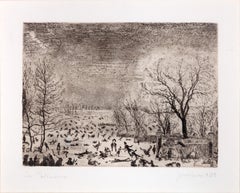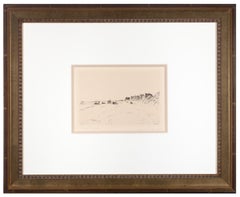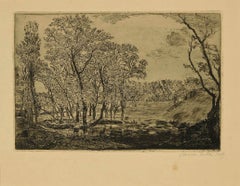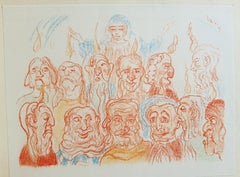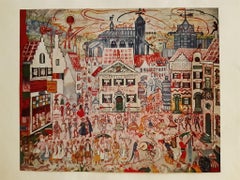James Ensor Art
James Ensor is a Belgian painter and printmaker and an important influence on Expressionism and Surrealism. Ensor's early works, such as Russian Music (1881) and The Drunkards (1883), depict realistic scenes in a somber style, after which his palette subsequently brightened and he favored increasingly bizarre subject matter. Such paintings as The Scandalized Masks (1883) and Skeletons Fighting over a Hanged Man (1891) feature figures in grotesque masks inspired by the ones sold in his mother's gift shop for Ostend's annual Carnival. Subjects such as carnivals, masks, puppetry, skeletons and fantastic allegories are dominant in Ensor's mature work. Ensor dressed skeletons up in his studio and arranged them in colorful, enigmatic tableaux on the canvas and used masks as a theatrical aspect in his still lifes. Attracted by masks' plastic forms, bright colors and potential for psychological impact, he created a format in which he could paint with complete freedom. Ensor was a prolific and accomplished printmaker. He created 133 etchings and drypoints throughout his career, with 86 of them made between 1886 and 1891 during the height of Ensor's most creative period. Ensor himself recognized that the prints were a key part of his artistic legacy, stating in a letter to Albert Croquez in 1934, "Yes, I intend to go on working for a long time yet so that generations to come may hear me. I intend to survive, and I think of the solid copper plate, the unalterable ink, easy reproduction, faithful prints and I adopt etching as a means of expression.”
Late 19th Century Realist James Ensor Art
Etching
Early 1900s James Ensor Art
Etching
1880s Modern James Ensor Art
Etching
1920s Expressionist James Ensor Art
Lithograph, Paper
Early 1900s Surrealist James Ensor Art
Etching
1880s Surrealist James Ensor Art
Etching
1890s Surrealist James Ensor Art
Etching
Late 19th Century James Ensor Art
Handmade Paper
1880s Modern James Ensor Art
Etching
1880s Modern James Ensor Art
Etching
1880s Symbolist James Ensor Art
Drypoint, Etching
1890s Post-Impressionist James Ensor Art
Etching
Mid-20th Century American Modern James Ensor Art
Drypoint, Etching
Mid-20th Century American Modern James Ensor Art
Drypoint, Etching
Mid-20th Century American Modern James Ensor Art
Drypoint, Etching
Early 20th Century American Modern James Ensor Art
Etching, Drypoint
Early 1900s Realist James Ensor Art
Etching
Late 19th Century Modern James Ensor Art
Etching
Early 20th Century Modern James Ensor Art
Drypoint, Etching
1970s Surrealist James Ensor Art
Etching
1880s Impressionist James Ensor Art
Etching
Early 20th Century Modern James Ensor Art
Drypoint, Etching, Aquatint
1840s Victorian James Ensor Art
Aquatint
Artist Comments
Artist Alix Palo portrays a delightful still life of a bouquet in a vase. The harmonious blend of purple, green, and yellow brings out the vibrancy of the flowe...
21st Century and Contemporary Expressionist James Ensor Art
Acrylic
1920s Expressionist James Ensor Art
Lithograph, Paper
Early 1900s Surrealist James Ensor Art
Etching
1890s Modern James Ensor Art
Etching
1880s Symbolist James Ensor Art
Etching
1890s Impressionist James Ensor Art
Etching
1880s Post-Impressionist James Ensor Art
Etching
1880s Post-Impressionist James Ensor Art
Etching
1880s Impressionist James Ensor Art
Etching
James Ensor art for sale on 1stDibs.
Artists Similar to James Ensor
- 1stDibs ExpertApril 5, 2022To show depth in his work, James Ensor would use linear perspective to set the scene for the observer. See the magic for yourself by shopping a selection of James Ensor’s pieces from some of the world’s top art dealers on 1stDibs.
